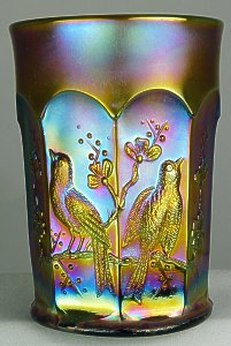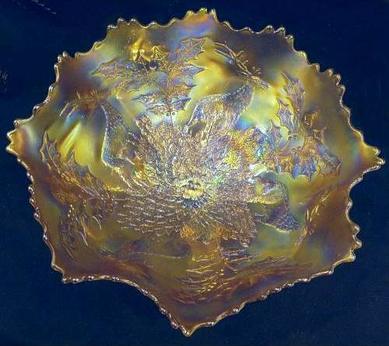The Earliest Carnival Pioneers
Who were May Plummer and Gertrude Conboy?
Two of the better known Carnival Pioneers are Marion Hartung and Rose Presznick, but as with all life, there are events and people that can become hidden from later history. Names get lost and forgotten, and yet in their own way these people were also vital in providing the foundation of knowledge and passion that we all enjoy today - step forward and take a bow, May Plummer and Gertrude Conboy.
Back in the 1940s and early 1950s, two women, May Plummer (from Philadelphia) and Gertrude Conboy (from Kansas) shared a deep and growing interest for “iridescent glass” (Carnival Glass) that they recorded through their fascinating correspondence. Indeed it was described as “A remarkable insight into the Carnival heritage” by O. Joe Olson.
The letters were preserved by Gertrude Conboy and the information was recorded by O. Joe Olson in his 1971 issues of “The Carnival Glass News and Views” newsletter. Thanks to both of these people for recognising the significance of the correspondence and preserving it for history.
|
Amazingly, we start our story back in 1944! Both Gertrude Conboy and May Plummer wrote to the well-known pattern glass author and researcher, Ruth Webb Lee, asking for her thoughts on the iridescent glass they were finding. Ruth Webb Lee wrote “I simply cannot imagine what the glass can be. I have never seen the ‘N’ mark, but thought it might be French ware and a Napoleon mark, though I could be mistaken.” |
Left: Harry Northwood's now famous N mark, unrecognised in 1944.
Centre: a tumbler described by May Plummer as "green and bronze with bird design (now known as Northwood's Singing Birds).
Right: "deep dessert dishes in orange with heavy grape design" (now known as Imperial's Heavy Grape pattern, picture courtesy of Seek Auctions.)
Centre: a tumbler described by May Plummer as "green and bronze with bird design (now known as Northwood's Singing Birds).
Right: "deep dessert dishes in orange with heavy grape design" (now known as Imperial's Heavy Grape pattern, picture courtesy of Seek Auctions.)
Ruth Webb Lee put Mrs Conboy and Mrs Plummer in touch with each other, and their correspondence began. The excitement felt by the two women as they realised they had each found a kindred spirit who was as enthralled and passionate as themselves, was palpable.
May Plummer described some of her 56 pieces that she had been collecting since around 1937 or 1938: “Nine matched tumblers in green and bronze with bird design marked circle-N and also six deep dessert dishes in orange with heavy grape design on each piece.” We now recognise them as Northwood's Singing Birds and Imperial's Heavy Grape patterns.
She described how she started to collect the glass in the late 1930s: “The glass was first brought to my notice by a friend who found a few pieces at a rural sale in a barn near Reading, Pa., in the heart of the Pennsylvania Dutch mountains. No one was interested in the glass and she bought it all for 15 cents. She knew I was interested in old glass and thought it would be fun for me to have these “Dutch monstrosities” to demonstrate the extremes of taste.”
Mrs Plummer asked her friend to get hold of any more glass like it, that she could find at sales – her friend replied, “You can’t mean you like it?” However, despite the lack of desire for the iridised glass in some quarters, others loved it, and soon the prices began to go up and May Plummer reported that “the dealers are now bidding on it at sales”.
Curiously, the first name for the glass that Mrs Plummer heard was “Centennial Flash” glass, as it was believed to have been launched for the exposition at Philadelphia in 1876. Mrs Plummer wasn’t convinced and she wrote her friend, Gertrude Conboy, saying “I don’t think that’s true, do you? I don’t think it’s as old as that. The fact that our mothers never saw it means that it was not in existence at that time when they were setting up housekeeping. My mother is positive she never saw a piece until she visited us and saw mine.”
Gertrude Conboy had also made a very important observation – the glass had been made for premiums (promotional free gifts with other goods).
|
Our extensive research into Mail Order and similar sales methods has shown that, although Carnival Glass was not made originally and intentionally for premiums and similar incentives, stock was subsequently purchased cheaply for that purpose. We have a unique look at how Mail Order was an essential part of the Carnival Glass story in our feature: "Sell it to Me!" However, the two women were definitely on to something – and they were right. May Plummer wrote: “it would account for the many odd pieces instead of mostly complete sets. Of course, the glass is definitely decorative rather than useful. The dessert dishes I spoke of are the only things I really use and the scraping of a spoon against the raised grapes (in the pattern) is not pleasant or satisfactory”. On the right is a typical Mail Order premium for these Imperial Open Rose bowls in a Perry G Mason catalogue, c.1925. Although this offer happened to be for a set, many of the other premiums or special offers were for individual items. You can see many of these Mail Order offers in our feature "Sell it to Me". |
|
Mrs Conboy once asked Mrs Plummer: “Do you have any all clear white iridescent pieces? I have a 7 inch plate with a criss cross design of what looks like tree twigs. It has lovely coloring and cost me 35 cents.” It was most likely Dugan-Diamond's Grapevine Lattice (as it is found in that size), but Apple Blossom Twigs is a very similar pattern. Both are pictured here on the right. And that was the problem faced by these early Pioneers - what to call the patterns, so that they and others had a common language to identify their pieces. They couldn't keep referring to "a plate with a criss cross design"! That was the critical part played by Marion Hartung and Rose Presznick: they brought an organised structure of pattern names, illustrated in their books. |
A prediction!
There was a delightful story of an older dealer who had been teased for displaying some Carnival in his window, back in 1939. Others had told him to put the glass back in his cellar but he replied: “You wait a few years! People are going to go crazy over it!” How right he was!
In one letter dated August 1944, May Plummer wrote to Gertude Conboy that she had “a beautiful piece called my Christmas dish. It is an orange 10 inch bowl with three feet; plain underneath but a reindeer and holly pattern on top. This is the only one I have seen and I paid $1.74 for it a year ago". Of course we now know this item to be Fenton's Stag and Holly, as shown below left.
A prediction!
There was a delightful story of an older dealer who had been teased for displaying some Carnival in his window, back in 1939. Others had told him to put the glass back in his cellar but he replied: “You wait a few years! People are going to go crazy over it!” How right he was!
In one letter dated August 1944, May Plummer wrote to Gertude Conboy that she had “a beautiful piece called my Christmas dish. It is an orange 10 inch bowl with three feet; plain underneath but a reindeer and holly pattern on top. This is the only one I have seen and I paid $1.74 for it a year ago". Of course we now know this item to be Fenton's Stag and Holly, as shown below left.
|
Obviously, back in those early days, there was absolutely no need for collectors to be concerned about fakes and reproductions. Over time however, the Stag and Holly pattern has become very popular, and it has attracted the attention of fakers. It is important to be able to identify them and we take a detailed look at Stag and Holly Fakes in our series of articles: Reissues, Reproductions & Fakes |
|
May Plummer also added that she had "two 9 inch peacock plates, both found in Philadelphia. One’s blue the other is green. One cost me $1 and the other cost me $2". WOW! Northwood's Peacock (on the Fence) items, and plates in particular such as the stippled version, above right, are amongst the most popular and sought-after Classic Carnival Glass pieces today. The women’s correspondence revealed a growing feeling for both of them that there were more patterns made in iridescent glass than they had previously thought. Mrs Plummer wrote about being offered a covered butter (the first she’d seen) but balked at the price of $22.50. She also realised though, that it was indicative of a growing demand by collectors for the glass. She wrote in 1944: “I think this glass is only in the first stages of recognition and that it will keep on going up and up! I think we should grab all we can while it is within our reach.” She mused over which piece she would keep if she had to give up her growing collection. Her choice was what we know as Kittens. She wrote: “I would keep my smallest dish which has the kitten and mice on it! Can’t see the mice unless you hold the dish to the light. I found it in 1942 for 25 cents.” In 1952, the first authoritative article about Carnival Glass appeared in the “Spinning Wheel” magazine, written by Gertrude Conboy, the cover of which is shown on the right. The title of the article was “The Glass of Many Names Now Known as Carnival”, and you can see it in the white label on the bottom right of the cover. The immense significance of this article was that it clearly and firmly established the name "Carnival Glass" as the definitive term that is now used by all collectors worldwide. It gave Carnival Glass the educational and sound basis that was needed for collecting to grow, and for the glass to be understood. May Plummer congratulated Mrs Conboy on the article, saying that it was detailed and interesting, and also the first to be seen in a national publication. Little could they have imagined how collecting this fabulous glass would become a worldwide success! |
Spinning Wheel magazine, January 1952.
“The Glass of Many Names Now Known as Carnival” by Gertrude Conboy |








